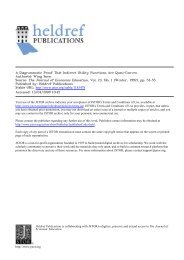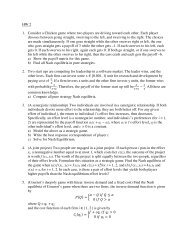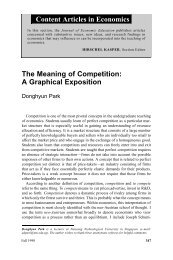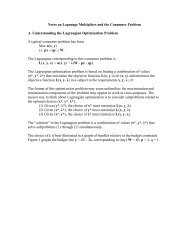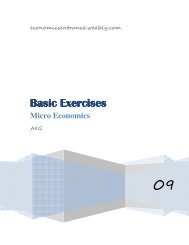Topics in Microeconomics 2009-10 Kirori Mal College, University of ...
Topics in Microeconomics 2009-10 Kirori Mal College, University of ...
Topics in Microeconomics 2009-10 Kirori Mal College, University of ...
Create successful ePaper yourself
Turn your PDF publications into a flip-book with our unique Google optimized e-Paper software.
<strong>Topics</strong> <strong>in</strong> <strong>Microeconomics</strong> <strong>2009</strong>-<strong>10</strong> <strong>Kirori</strong> <strong>Mal</strong> <strong>College</strong>, <strong>University</strong> <strong>of</strong> Delhi<br />
HW 1<br />
1. Consider the follow<strong>in</strong>g game:<br />
2.
<strong>Topics</strong> <strong>in</strong> <strong>Microeconomics</strong> <strong>2009</strong>-<strong>10</strong> <strong>Kirori</strong> <strong>Mal</strong> <strong>College</strong>, <strong>University</strong> <strong>of</strong> Delhi<br />
HW 2<br />
Suppose a parent and child play the follow<strong>in</strong>g game, first analyzed by Becker (1974). First child takes the<br />
action, A ≥ 0, that produces <strong>in</strong>come for the child, IC(A), and <strong>in</strong>come for the parent, IP(A). Second, the<br />
parent observes the <strong>in</strong>comes IC and IP and then chooses a bequest, B, to leave to the child. The child’s<br />
pay<strong>of</strong>f is U(IC+B)= log(IC+B); the parent’s is U(IP-B)+kU(IC+B) = log(IP - B)+klog(IC + B), where k > 0<br />
reflects the parent’s concern for the child well-be<strong>in</strong>g. Assume: bequest B can be positive or negative, the<br />
<strong>in</strong>come functions IC (A) and IP (A) are strictly concave and are maximized at AC >0 and AP > 0,<br />
respectively. Verify the “Rotten Kid” theorem: <strong>in</strong> the backwards <strong>in</strong>duction outcome, the child chooses the<br />
action that maximizes the family’s aggregate <strong>in</strong>come, IC(A)+IP(A), even though only the parent’s pay<strong>of</strong>f<br />
exhibits altruism.
<strong>Topics</strong> <strong>in</strong> <strong>Microeconomics</strong> <strong>2009</strong>-<strong>10</strong> <strong>Kirori</strong> <strong>Mal</strong> <strong>College</strong>, <strong>University</strong> <strong>of</strong> Delhi<br />
HW 3<br />
A. Read Chapter 5 <strong>of</strong> the text book.<br />
B. Refer the problem with players Karl, Rosa and Ernesto that was discussed <strong>in</strong> class. F<strong>in</strong>d a<br />
Nash equilibrium (that is not subgame perfect) other than the one we found <strong>in</strong> class.<br />
C. Do the follow<strong>in</strong>g problems:<br />
1. There is a selection committee with three members (1, 2 and 3) who have to choose one <strong>of</strong> four<br />
candidates (a, b, c and d). The preferences <strong>of</strong> the members among the candidates are as follows<br />
u1(d) < u1(c) < u1(b)< u1(a)<br />
u2(c) < u2(d) < u2(a)< u2(b)<br />
u3(c) < u3(a) < u3(b)< u3(d)<br />
where ui is the utility function <strong>of</strong> person i. The follow<strong>in</strong>g procedure is used to choose among the<br />
candidates. First, Member 1 vetoes one <strong>of</strong> the candidates, thereby knock<strong>in</strong>g him out <strong>of</strong> contention.<br />
Then Member 2 vetoes one <strong>of</strong> the three rema<strong>in</strong><strong>in</strong>g candidates, thereby knock<strong>in</strong>g him out <strong>of</strong><br />
contention. F<strong>in</strong>ally, Member 3 vetoes one <strong>of</strong> the two rema<strong>in</strong><strong>in</strong>g candidates. The candidate not<br />
vetoed by any <strong>of</strong> the members is chosen. Each member wishes to maximize his utility.<br />
Who will Member 1 veto? Who will Member 2 veto? Who will Member 3 veto? Justify your<br />
answers.<br />
(H<strong>in</strong>t: From the po<strong>in</strong>t <strong>of</strong> view <strong>of</strong> any particular committee member, maximization <strong>of</strong> his utility<br />
requires him to look forward and predict the behavior <strong>of</strong> members who will exercise their veto<br />
after that particular committee member. In particular, you are asked to f<strong>in</strong>d subgame perfect<br />
outcome <strong>of</strong> the game)<br />
Also answer the follow<strong>in</strong>g questions.<br />
a) Write down the set <strong>of</strong> players, set <strong>of</strong> term<strong>in</strong>al histories, player function, and players’<br />
preferences for the game.<br />
b) How many strategies does each player have?<br />
c) F<strong>in</strong>d a Nash equilibrium <strong>of</strong> the above game which is not Subgame perfect.<br />
2. Three friends take part <strong>in</strong> the follow<strong>in</strong>g pizza splitt<strong>in</strong>g game. In period 1, friend 1 is asked to split<br />
the pizza <strong>of</strong> size 1 <strong>in</strong>to at most two parts (i.e. he is free to not split the pizza at all). Let the two<br />
result<strong>in</strong>g fractions <strong>of</strong> pizza be p1 and 1-p1 . In period 2, friend 2 is asked to make a s<strong>in</strong>gle split on<br />
any one <strong>of</strong> the exist<strong>in</strong>g pizza parts (aga<strong>in</strong> he is free to make no split at all). Once the two friends<br />
have made their splitt<strong>in</strong>g decisions, period 3 comes and friend 3 is asked to choose one <strong>of</strong><br />
possible many pizza parts on the table. This is followed by friend 2 choos<strong>in</strong>g one <strong>of</strong> the rema<strong>in</strong><strong>in</strong>g<br />
parts. Whatever is left is consumed by friend 1. If you were friend 1 (and you and your friends all<br />
liked pizza), what would your choice <strong>of</strong> p1 be?
<strong>Topics</strong> <strong>in</strong> <strong>Microeconomics</strong> <strong>2009</strong>-<strong>10</strong> <strong>Kirori</strong> <strong>Mal</strong> <strong>College</strong>, <strong>University</strong> <strong>of</strong> Delhi<br />
HW 4<br />
A. Do the follow<strong>in</strong>g problems:<br />
1. Consider a market <strong>in</strong> which there are two firms, both produc<strong>in</strong>g the same good. Firm i’s cost<br />
<strong>of</strong> produc<strong>in</strong>g qi units <strong>of</strong> the good is Ci(qi) = 8qi for each i ∈ {1, 2}; the price at which output<br />
is sold when the total output is Q is Pd(Q) = max{24 – Q, 0}, where Q = q1 + q2. Each firm’s<br />
strategic variable is output and the firms make their decisions sequentially: one firm chooses<br />
its output, then the other firm does so, know<strong>in</strong>g the output chosen by the first firm.<br />
a) Model this situation as an extensive game.<br />
Players:<br />
Term<strong>in</strong>al Histories:<br />
Player function:<br />
Preferences:<br />
b) F<strong>in</strong>d the subgame perfect equilibrium and outcome <strong>of</strong> Stackelberg’s duopoly game.<br />
Equilibrium: Strategy <strong>of</strong> firm 1 →<br />
Strategy <strong>of</strong> firm 2 →<br />
Outcome:<br />
c) Consider a variant <strong>of</strong> the situation <strong>in</strong> which firm 2 has some fixed cost <strong>of</strong> production (f > 0):<br />
C2(q2) = f + 8q2 for q2 > 0<br />
= 0 for q2 = 0<br />
F<strong>in</strong>d the subgame perfect equilibrium and outcome <strong>of</strong> Stackelberg’s duopoly game <strong>in</strong> each <strong>of</strong><br />
the follow<strong>in</strong>g cases:<br />
i) f = 1<br />
Equilibrium: Strategy <strong>of</strong> firm 1 →<br />
Strategy <strong>of</strong> firm 2 →<br />
Outcome:<br />
ii) f = 9<br />
Equilibrium: Strategy <strong>of</strong> firm 1 →<br />
Strategy <strong>of</strong> firm 2 →<br />
Outcome:<br />
iii) f = 25<br />
Equilibrium: Strategy <strong>of</strong> firm 1 →<br />
Strategy <strong>of</strong> firm 2 →<br />
Outcome:
<strong>Topics</strong> <strong>in</strong> <strong>Microeconomics</strong> <strong>2009</strong>-<strong>10</strong> <strong>Kirori</strong> <strong>Mal</strong> <strong>College</strong>, <strong>University</strong> <strong>of</strong> Delhi<br />
2. Consider a market <strong>in</strong> which there are three firms, all produc<strong>in</strong>g the same good. Firm i’s cost<br />
<strong>of</strong> produc<strong>in</strong>g qi units <strong>of</strong> the good is Ci(qi) = 0 for each i ∈ {1, 2, 3}; the price at which output<br />
is sold when the total output is Q is Pd(Q) = max{32 – Q, 0}, where Q = q1 + q2 + q3. Each<br />
firm’s strategic variable is output and the firms make their decisions sequentially: one firm<br />
chooses its output, then the second firm does so, know<strong>in</strong>g the output chosen by the first firm,<br />
and f<strong>in</strong>ally the third firm makes its choice <strong>of</strong> output know<strong>in</strong>g the output chosen by the first<br />
two firms.<br />
a) Model this situation as an extensive game.<br />
Players:<br />
Term<strong>in</strong>al Histories:<br />
Player function:<br />
Preferences:<br />
b) F<strong>in</strong>d the subgame perfect equilibrium and outcome <strong>of</strong> Stackelberg’s duopoly game.<br />
Equilibrium: Strategy <strong>of</strong> firm 1 →<br />
Strategy <strong>of</strong> firm 2 →<br />
Strategy <strong>of</strong> firm 3 →<br />
Outcome:<br />
c) Can you suggest a Nash Equilibrium strategy pr<strong>of</strong>ile which results <strong>in</strong> an outcome different<br />
from the one which results from subgame perfect equilibrium above?<br />
Equilibrium: Strategy <strong>of</strong> firm 1 →<br />
Strategy <strong>of</strong> firm 2 →<br />
Strategy <strong>of</strong> firm 3 →<br />
Outcome:
<strong>Topics</strong> <strong>in</strong> <strong>Microeconomics</strong> <strong>2009</strong>-<strong>10</strong> <strong>Kirori</strong> <strong>Mal</strong> <strong>College</strong>, <strong>University</strong> <strong>of</strong> Delhi<br />
3. A legislature has k members, where k is an odd number. Two rival bills, X and Y, are be<strong>in</strong>g<br />
considered. The bill that attracts the votes <strong>of</strong> a majority <strong>of</strong> legislators will pass. Interest<br />
group X favors bill X, whereas <strong>in</strong>terest group Y favors bill Y. Each group wishes to entice a<br />
majority <strong>of</strong> legislators to vote for its favorite bill. First <strong>in</strong>terest group X gives an amount <strong>of</strong><br />
money (possibly zero) to each legislator, then <strong>in</strong>terest group Y does so. Each <strong>in</strong>terest group<br />
wishes to spend as little as possible. Group X values the pass<strong>in</strong>g <strong>of</strong> bill X at $VX > 0 and the<br />
pass<strong>in</strong>g <strong>of</strong> bill Y at zero, and group Y values the pass<strong>in</strong>g <strong>of</strong> bill Y at $VY > 0 and the pass<strong>in</strong>g<br />
<strong>of</strong> bill X at zero. (For example, group X is <strong>in</strong>different between an outcome <strong>in</strong> which it spends<br />
VX and bill X is passed and one <strong>in</strong> which it spends noth<strong>in</strong>g and bill Y is passed.) Each<br />
legislator votes for the favored bill <strong>of</strong> the <strong>in</strong>terest group that <strong>of</strong>fers her the most money; a<br />
legislator to whom both groups <strong>of</strong>fer the same amount <strong>of</strong> money votes for bill Y (an arbitrary<br />
assumption that simplifies the analysis without qualitatively chang<strong>in</strong>g the outcome). For<br />
example, if k = 3, the amounts <strong>of</strong>fered to the legislators by group X are x = (<strong>10</strong>0, 50, 0), and<br />
the amounts <strong>of</strong>fered by group Y are y = (<strong>10</strong>0, 0, 50), then legislators 1 and 3 vote for Y and<br />
legislator 2 votes for X, so that Y passes. (In some legislatures the <strong>in</strong>ducements <strong>of</strong>fered to<br />
legislators are more subtle than cash transfers.)<br />
We can model this situation as the follow<strong>in</strong>g extensive game.<br />
Players The two <strong>in</strong>terest groups, X and Y.<br />
Term<strong>in</strong>al histories The set <strong>of</strong> all sequences (x, y), where x is a list <strong>of</strong> payments to legislators<br />
made by <strong>in</strong>terest group X and y is a list <strong>of</strong> payments to legislators made by <strong>in</strong>terest group Y.<br />
(That is, both x and y are lists <strong>of</strong> k nonnegative <strong>in</strong>tegers.)<br />
Player function P(∅) = X and P(x) = Y for all x.<br />
Preferences The preferences <strong>of</strong> <strong>in</strong>terest group X are represented by the pay<strong>of</strong>f function<br />
where bill Y passes after the term<strong>in</strong>al history (x, y) if and only if the number <strong>of</strong> components <strong>of</strong><br />
y that are at least equal to the correspond<strong>in</strong>g components <strong>of</strong> x is at least 0.5 (k + 1) (a bare<br />
majority <strong>of</strong> the k legislators). The preferences <strong>of</strong> <strong>in</strong>terest group Y are represented by the<br />
analogous function (where VY replaces VX, y replaces x, and Y replaces X).<br />
F<strong>in</strong>d the subgame perfect equilibrium and outcome <strong>of</strong> the above game <strong>in</strong> each <strong>of</strong> the<br />
follow<strong>in</strong>g cases:<br />
i) VX = 900, VY = 600 and k = 5<br />
Equilibrium: Strategy <strong>of</strong> group X →<br />
Strategy <strong>of</strong> group Y →<br />
Outcome:<br />
ii) VX = 1200, VY = 600 and k = 3<br />
Equilibrium: Strategy <strong>of</strong> group X →<br />
Strategy <strong>of</strong> group Y →<br />
Outcome:
<strong>Topics</strong> <strong>in</strong> <strong>Microeconomics</strong> <strong>2009</strong>-<strong>10</strong> <strong>Kirori</strong> <strong>Mal</strong> <strong>College</strong>, <strong>University</strong> <strong>of</strong> Delhi<br />
4. (Multiple choice question) There is a pile <strong>of</strong> 17 matchsticks on a table. Players 1 and 2 take<br />
turns <strong>in</strong> remov<strong>in</strong>g matchsticks from the pile, start<strong>in</strong>g with player 1. On each turn, a player<br />
has to remove a number <strong>of</strong> sticks that equals the square <strong>of</strong> a positive <strong>in</strong>teger, such that the<br />
number <strong>of</strong> matchsticks that rema<strong>in</strong> on the table equals some non-negative <strong>in</strong>teger. The<br />
player, who cannot do so, when it is his /her turn, loses. Which <strong>of</strong> the follow<strong>in</strong>g statements is<br />
true?<br />
a) If player 2 plays appropriately, he/she can w<strong>in</strong> regardless <strong>of</strong> how 1 actually plays.<br />
b) If player 1 plays appropriately, he/she can w<strong>in</strong> regardless <strong>of</strong> how 2 actually plays.<br />
c) Both players have a chance to w<strong>in</strong>, if they play correctly.<br />
d) The outcome <strong>of</strong> the game cannot be predicted on the basis <strong>of</strong> the data given.<br />
5. Each <strong>of</strong> n ≥ 2, i = 1, ..., n can make contributions si ∈ [0, w] (w > 0) to the production <strong>of</strong><br />
some public good. The contributions are made sequentially, that is, beg<strong>in</strong>n<strong>in</strong>g with <strong>in</strong>dividual<br />
1, each <strong>in</strong>dividual i makes the contribution after 1, …, i - 1 have contributed and before i +<br />
1,…., n make their contributions. Assume that each <strong>in</strong>dividual i observes the contributions <strong>of</strong><br />
the preced<strong>in</strong>g i - 1 contributors before choos<strong>in</strong>g her contribution. Their pay<strong>of</strong>f functions are<br />
given by πi (s1, .., sn) = n(m<strong>in</strong>{s1, .., sn}) − si.<br />
a) Model this situation as an extensive game.<br />
Players:<br />
Term<strong>in</strong>al Histories:<br />
Player function:<br />
Preferences:<br />
b) F<strong>in</strong>d the subgame perfect equilibrium and outcome <strong>of</strong> the game <strong>in</strong> question.<br />
Equilibrium: Strategy <strong>of</strong> <strong>in</strong>dividual 1 →<br />
Strategy <strong>of</strong> <strong>in</strong>dividual 2 →<br />
Strategy <strong>of</strong> <strong>in</strong>dividual 3 →<br />
..<br />
Strategy <strong>of</strong> <strong>in</strong>dividual i →<br />
Outcome:<br />
B. Read Chapter 5 and 6 <strong>of</strong> the text book and try all the problems.
<strong>Topics</strong> <strong>in</strong> <strong>Microeconomics</strong> <strong>2009</strong>-<strong>10</strong> <strong>Kirori</strong> <strong>Mal</strong> <strong>College</strong>, <strong>University</strong> <strong>of</strong> Delhi<br />
HW 5<br />
1. Consider the follow<strong>in</strong>g game played between players 1 and 2. Player 1 moves first and plays<br />
either L or R. This is observed by both the players. If L is played, players 1 and 2 simultaneously<br />
choose from the sets {l, r} and {t, d} respectively and the game ends with pay<strong>of</strong>fs (3, 1), (0, 0), (0,<br />
0) and (1, 3) if (l, t), (l, d), (r, t) and (r, d) are played respectively. If Player 1 plays R, players 1<br />
and 2 simultaneously choose from the sets {m, n} and {q, s} respectively and the game ends with<br />
pay<strong>of</strong>fs (2, 1), (1, 2), (1, 2) and (2, 1) if (m, q), (m, s), (n, q) and (n, s) are played respectively.<br />
(i) Model this game as an extensive form game with perfect <strong>in</strong>formation and simultaneous<br />
moves.<br />
(ii) Compute all subgame perfect Nash equilibria (SPNE) <strong>in</strong> the game.<br />
2. Players 1 and 2 choose an element <strong>of</strong> the set {1, ...,K}. If the players choose the same number,<br />
then player 2 pays 1 to player 1; otherwise no payment is made. F<strong>in</strong>d all pure and mixed strategy<br />
Nash equilibria <strong>of</strong> this game.<br />
3. Def<strong>in</strong>e a Bayesian game. Formulate problems 4 through 8 as Bayesian games (i.e. specify<br />
players, states, actions, signals, beliefs, pay<strong>of</strong>f functions)<br />
4. Consider a Cournot duopoly game with <strong>in</strong>complete <strong>in</strong>formation. Suppose that demand is given by<br />
p = max{1 – Q, 0}, where Q is the total quantity produced <strong>in</strong> the <strong>in</strong>dustry. Firm 1 selects a<br />
quantity q1, which it produces at zero cost. Firm 2’s cost <strong>of</strong> production is private <strong>in</strong>formation<br />
(selected by nature). With probability ½, firm 2 produces at zero cost. With probability ½, firm 2<br />
produces with a marg<strong>in</strong>al cost <strong>of</strong> ¼. Call the former type <strong>of</strong> firm 2 “L” and the latter type “H”<br />
(for low and high cost, respectively). Firm 2 knows its type, whereas firm 1 knows only the<br />
probability that L and H occur. Let q2 H and q2 L denote the quantities selected by the two types <strong>of</strong><br />
firm 2. Then when firm 2’s type is L, its pay<strong>of</strong>f is given by u2 L = (1 – q1 – q2 L )q2 L . When firm 2’s<br />
type is H, its pay<strong>of</strong>f is u2 L = (1 – q1 – q2 H )q2 H – (q2 H )/4. As a function <strong>of</strong> the strategy pr<strong>of</strong>ile (q1; q2 L ,<br />
q2 H ), firm 1’s pay<strong>of</strong>f is u1 = ((1 – q1 – q2 L )q1)/2 + ((1 – q1 – q2 H )q1)/2<br />
Solve for Bayesian Nash Equilibrium. (Ans. (q1; q2 L , q2 H )= (3/8; 5/16, 3/16))<br />
5. Consider a simple simultaneous-bid poker game. First, nature selects numbers x1 and x2. Assume<br />
that these numbers are <strong>in</strong>dependently and uniformly distributed between 0 and 1. Player 1<br />
observes x1 and player 2 observes x2, but neither player observes the number given to the other<br />
player. Simultaneously and <strong>in</strong>dependently, the players choose either to fold or to bid. If both<br />
players fold, then they both get the pay<strong>of</strong>f –1. If only one player folds, then he obta<strong>in</strong>s –1 while<br />
the other player gets 1. If both players elected to bid, then each player receives 2 if his number is<br />
at least as large as the other player’s number; otherwise, he gets –2. Compute the Bayesian Nash<br />
equilibrium <strong>of</strong> this game. (H<strong>in</strong>t: Look for a symmetric equilibrium <strong>in</strong> which a player bids if and<br />
only if his number is greater than some constant α. Your analysis will reveal the equilibrium<br />
value <strong>of</strong> α.)<br />
6. Consider the follow<strong>in</strong>g game. Nature selects A with probability ½ and B with probability ½. If<br />
nature selects A, then players 1 and 2 <strong>in</strong>teract accord<strong>in</strong>g to matrix “A”. If nature selects B, then
<strong>Topics</strong> <strong>in</strong> <strong>Microeconomics</strong> <strong>2009</strong>-<strong>10</strong> <strong>Kirori</strong> <strong>Mal</strong> <strong>College</strong>, <strong>University</strong> <strong>of</strong> Delhi<br />
the players <strong>in</strong>teract accord<strong>in</strong>g to matrix “B”. Suppose that, before the players select their<br />
actions, player 1 observes nature’s choice. (That is, player 1 knows which matrix is be<strong>in</strong>g<br />
played.) Player 2 does not observe nature’s choice. These matrices are pictured here.<br />
Solve for Bayesian Nash equilibrium.<br />
A B<br />
1↓2 → L R 1↓2 → L R<br />
U 2, 1 0, 0 U 1, 2 0, 0<br />
D 0, 0 1, 2 D 0, 0 2, 1<br />
7. Suppose that a public good is provided to a group <strong>of</strong> people if at least one person is will<strong>in</strong>g to<br />
pay the cost <strong>of</strong> the good. Assume that the people differ <strong>in</strong> their valuations <strong>of</strong> the good, and each<br />
person knows only her own valuation. Denote the number <strong>of</strong> <strong>in</strong>dividuals by n, the cost <strong>of</strong> the good<br />
by c > 0, and <strong>in</strong>dividual i’s pay<strong>of</strong>f if the good is provided by vi. If the good is not provided then<br />
each <strong>in</strong>dividual’s pay<strong>of</strong>f is 0. Each <strong>in</strong>dividual i knows her own valuation vi. She does not know<br />
anyone else’s valuation, but knows that all valuations are at least vL and at most vH, where 0 ≤ vL<br />
< c < vH. She believes that the probability that any one <strong>in</strong>dividual’s valuation is at most v is F(v),<br />
<strong>in</strong>dependent <strong>of</strong> all other <strong>in</strong>dividuals’ valuations, where F is a cont<strong>in</strong>uous <strong>in</strong>creas<strong>in</strong>g function.<br />
Suppose F(v) = max{0, m<strong>in</strong>{(v – vL)/ (vH – vL), 1}} i.e. uniform distribution from vL to vH.<br />
The follow<strong>in</strong>g mechanism determ<strong>in</strong>es whether the good is provided. All n <strong>in</strong>dividuals<br />
simultaneously submit envelopes; the envelope <strong>of</strong> any <strong>in</strong>dividual i may conta<strong>in</strong> either a<br />
contribution <strong>of</strong> c or noth<strong>in</strong>g (no <strong>in</strong>termediate contributions are allowed). If all <strong>in</strong>dividuals submit<br />
0 then the good is not provided and each <strong>in</strong>dividual’s pay<strong>of</strong>f is 0. If at least one <strong>in</strong>dividual<br />
submits c then the good is provided, each <strong>in</strong>dividual i who submits c obta<strong>in</strong>s the pay<strong>of</strong>f vi − c, and<br />
each <strong>in</strong>dividual i who submits 0 obta<strong>in</strong>s the pay<strong>of</strong>f vi. Solve for the Bayesian Nash equilibrium<br />
when n = 2 and n = 3.<br />
8. Consider a Coumot duopoly operat<strong>in</strong>g <strong>in</strong> a market with <strong>in</strong>verse demand P(Q) = max{a – Q, 0},<br />
where Q = q1+ q2 is the aggregate quantity on the market. Both firms have total costs c(qi) = cqi,<br />
but demand is uncerta<strong>in</strong>: it is high (a = aH) with probability θ and low (a = aL) with probability<br />
1– θ. Furthermore, <strong>in</strong>formation is asymmetric: firm 1 knows whether demand is high or low, but<br />
firm 2 does not. All <strong>of</strong> this is common knowledge. The two firms simultaneously choose quantities.<br />
Suppose aH = <strong>10</strong>0, aL = 80, θ = 0.5, and c = 0. What is the Bayesian Nash equilibrium <strong>of</strong> this<br />
game?<br />
9. Consider the first-price sealed-bid auction, but each bidder i observes only his own valuation vi.<br />
The valuation is distributed uniformly and <strong>in</strong>dependently on [0, v*] for each bidder. Derive<br />
symmetric (pure strategy) Bayesian Nash equilibrium <strong>of</strong> this auction if there are two bidders.<br />
Suppose that bids can only be non-negative. (Look for an equilibrium <strong>in</strong> which bidder i’s bid is a<br />
l<strong>in</strong>ear function <strong>of</strong> his valuation.)
<strong>Topics</strong> <strong>in</strong> <strong>Microeconomics</strong> <strong>2009</strong>-<strong>10</strong> <strong>Kirori</strong> <strong>Mal</strong> <strong>College</strong>, <strong>University</strong> <strong>of</strong> Delhi<br />
HW 6<br />
1. Consider an “all-pay auction” with two players (the bidders). Player 1’s valuation v1 for the<br />
object be<strong>in</strong>g auctioned is uniformly distributed between 0 and 1. That is, for any x∈ [0, 1], player<br />
1’s valuation is below x with probability x. Player 2’s valuation is also uniformly distributed<br />
between 0 and 1, so the game is symmetric. After nature chooses the players’ valuations, each<br />
player observes his/her own valuation but not that <strong>of</strong> the other player. Simultaneously and<br />
<strong>in</strong>dependently, the players submit bids. The player who bids higher w<strong>in</strong>s the object, but both<br />
players must pay their bids. That is, if player i bids bi, then his/her pay<strong>of</strong>f is – bi if he/she does not<br />
w<strong>in</strong> the auction; his/her pay<strong>of</strong>f is vi – bi if he/she w<strong>in</strong>s the auction. Calculate the Bayesian Nash<br />
Equilibrium strategies (bidd<strong>in</strong>g functions). (H<strong>in</strong>t: The equilibrium bidd<strong>in</strong>g function for player I is<br />
<strong>of</strong> the form bi(vi) = kvi 2 for some k.)<br />
2. Consider a “common-value auction” with two players, where the value <strong>of</strong> the object be<strong>in</strong>g<br />
auctioned is the same for both players. Call this value Y and suppose that Y = y1 + y2, where y1<br />
and y2 are both uniformly distributed between 0 and <strong>10</strong>. That is, for any x ∈ [0, <strong>10</strong>], we have y1 <<br />
x with probability x/<strong>10</strong>. Suppose that player 1observes y1 (but does not observe y2) and that<br />
player 2 observes y2 (but does not observe y1). The players simultaneously submit bids, b1 and b2.<br />
If player i bids higher than does player j, then player I w<strong>in</strong>s the auction and gets the pay<strong>of</strong>f Y – b<br />
whereas player j gets 0.<br />
a) Suppose player 2 uses the bidd<strong>in</strong>g strategy b2(y2) = 3 + y2. What is player 1’s best-response<br />
bidd<strong>in</strong>g strategy?<br />
b) Suppose each player will not select a strategy that would surely give him/her a negative<br />
pay<strong>of</strong>f conditional on w<strong>in</strong>n<strong>in</strong>g the auction. Suppose also that this fact is common knowledge<br />
between the players. What can you conclude about how high the players are will<strong>in</strong>g to bid?
<strong>Topics</strong> <strong>in</strong> <strong>Microeconomics</strong> <strong>2009</strong>-<strong>10</strong> <strong>Kirori</strong> <strong>Mal</strong> <strong>College</strong>, <strong>University</strong> <strong>of</strong> Delhi<br />
HW 7<br />
In a 2 x 2 signal<strong>in</strong>g game, there can be any or all <strong>of</strong> the follow<strong>in</strong>g Weak Sequential Equilibria (WSE):<br />
both types <strong>of</strong> Player 1 may play pure strategies <strong>in</strong> equilibrium (if they play the same strategy, we say it is<br />
a pool<strong>in</strong>g equilibrium; if they differ, we say it is a separat<strong>in</strong>g equilibrium); one type <strong>of</strong> Player 1 may play<br />
a pure strategy while the other plays a mixed strategy (lead<strong>in</strong>g to a semi-separat<strong>in</strong>g equilibrium); or both<br />
types <strong>of</strong> Player 1 may play mixed strategies. (We won’t deal with the latter two cases.)<br />
When look<strong>in</strong>g for a WSE...<br />
1. Decide whether you’re look<strong>in</strong>g for a separat<strong>in</strong>g or pool<strong>in</strong>g equilibrium.<br />
2. Assign a strategy (a message for each type) to Player 1; make sure it is not strictly dom<strong>in</strong>ated.<br />
3. Derive beliefs for Player 2 accord<strong>in</strong>g to Bayes’ rule at each <strong>in</strong>formation set reached with positive<br />
probability along the equilibrium path. Set arbitrary beliefs for Player 2 at <strong>in</strong>formation sets that are<br />
never reached along the equilibrium path.<br />
4. Determ<strong>in</strong>e Player 2’s best response.<br />
5. In view <strong>of</strong> Player 2’s response, check to see whether Player 1 has an <strong>in</strong>centive to deviate from the<br />
strategy you assigned her <strong>in</strong> any state <strong>of</strong> the world (<strong>in</strong> other words, for all types <strong>of</strong> Player 1). If she does<br />
not, you have found a WSE. If she does, this is not an equilibrium - return to step 2 and assign Player 1 a<br />
different strategy.<br />
6. Once you have exhausted all possible strategies with<strong>in</strong> an equilibrium subset, return to step 1 and<br />
select a different type <strong>of</strong> WSE.<br />
F<strong>in</strong>d WSE for the follow<strong>in</strong>g game:<br />
A signal<strong>in</strong>g game <strong>in</strong> which there are two types <strong>of</strong> player 1, strong and weak, the probabilities <strong>of</strong> these<br />
types are 0.9 and 0.1 respectively, the set <strong>of</strong> messages is {B, Q} (the consumption <strong>of</strong> beer or quiche for<br />
breakfast), and player 2 has two actions, F(ight) or N(ot). Player 1's pay<strong>of</strong>f is the sum <strong>of</strong> two elements:<br />
she obta<strong>in</strong>s two units if player 2 does not fight and one unit if she consumes her preferred breakfast (B if<br />
she is strong and Q if she is weak). Player 2's pay<strong>of</strong>f does not depend on player 1's breakfast; it is 1 if he<br />
fights the weak type or if he does not fight the strong type.


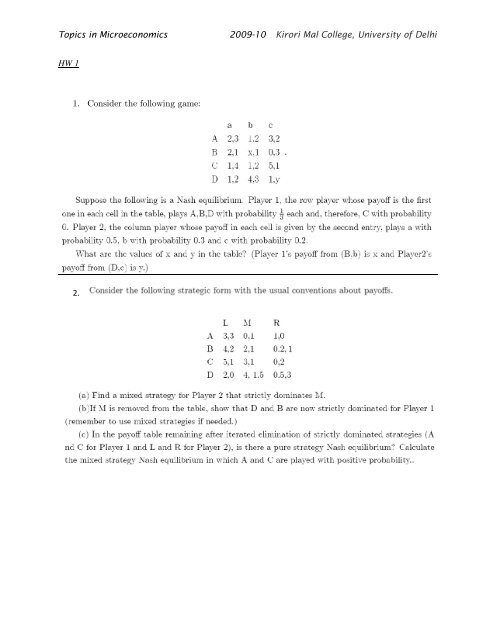

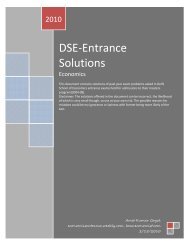
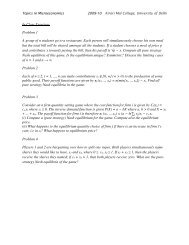


![2. Each of n ≥ 2, i = 1, ..., n can make contributions s i ∈ [0, w] (w ...](https://img.yumpu.com/19311695/1/190x245/2-each-of-n-2-i-1-n-can-make-contributions-s-i-0-w-w-.jpg?quality=85)
